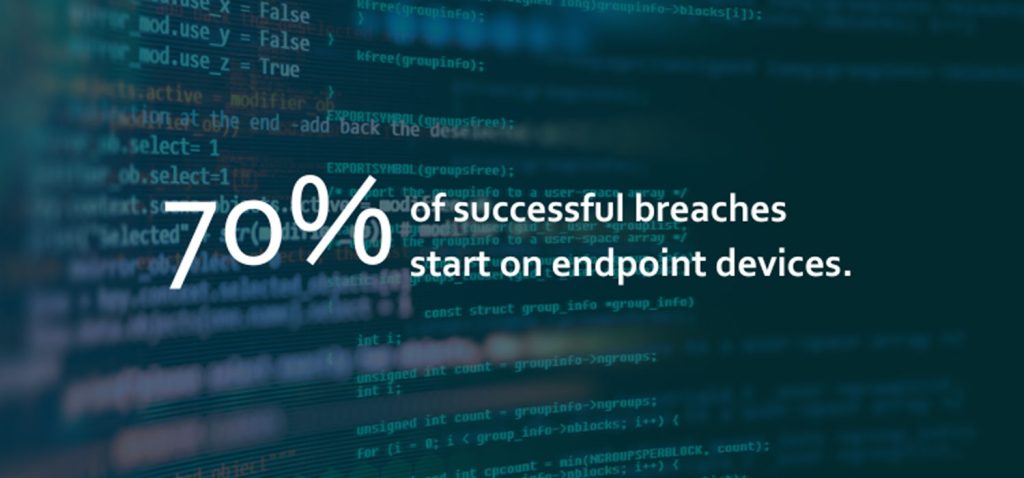
Today’s cybersecurity frameworks are inherently complex. With servers, printers, machinery and now remote computers and cellphones it has become difficult for organizations to create a unified approach to endpoint operations. From hiring qualified professionals to implementing best practices and maintaining critical infrastructure, many security teams need assistance.
Today, endpoint detection and response (EDR) services are a necessity for businesses trying to protect valuable data. EDR helps security teams gain visibility into their network, detect threats faster and mitigate the potential impact of a breach.
What is endpoint detection and response?
Endpoint Detection and Response (EDR) is an endpoint security solution that continuously monitors end-user devices to detect and respond to cyber threats. It is a system that gathers and analyzes threat-related information like ransomware and malware throughout your network. The goal of EDR services is to reduce attacker dwell time and mitigate the potential impact of a breach.
How does it work?
EDR security solutions work by monitoring endpoints and network activities taking place on all devices and technology. The solution technology then records all of this information in a central database where further investigation can take place. EDR provides security teams with increased visibility into what is happening on your endpoints at all times. It also puts automation processes in place so response and remediation can occur much faster.
Key Functions of EDR
- Develop a quantitative and qualitative understanding of organizational risks posed by people, endpoints, data, and technologies prior to an incident
- Identify threat patterns by analyzing activity and data
- Implement a set of advanced security controls to monitor, identify, and mitigate risks through intelligent threat defense and threat hunting
- Automatically respond to threats to remove or contain them, and notify security personnel
- Capture and secure all relevant security information for future use
- Use data forensics to identify threats and assess suspicious activities
Why do you need EDR?

Unfortunately, in today’s threat landscape there is too much at stake to not have an EDR plan in place. It is increasingly difficult to protect your network from advanced attacks that enter through endpoints. Cyber-attacks are more frequently occurring on individual computers and devices, with nearly 70% of successful breaches starting on endpoint devices.
While yes, threat prevention tools can stop the majority of attacks automatically, the most sophisticated and damaging attacks require detection and response. These endpoint attacks are typically low and slow attacks that require manual verification from analysts. And most of the time the only way to identify these attacks is by analyzing activity over time and machine learning across data sources.
Luckily, EDR tools detect and protect your organization from advanced forms of malware, suspicious user activity, advanced persistent threats (APT), phishing, etc. Compared to legacy security technology, EDR provides enhanced visibility into your endpoints allowing your team to minimize the gap between the speed of compromise and speed of detection with proactive threat hunting and incident response services.
EDR not only learns how attackers break into your network but also detects their path of activity. You can track how threat actors learn about your network, move between devices and technology and attempt to steal data. This allows you to identify gaps, and patch the network as you go.
Elements of an EDR Program
- Threat profiling: assess your organization’s attack surface, critical infrastructure, sensitive data, and operational processes, to lay the foundation for a robust defense strategy.
- Threat defense: utilize industry-leading endpoint technology to prevent, contain, and remediate attacks from all threat vectors.
- Threat hunting: deploy manual and automated threat hunting techniques to improve your threat hunting programs. Collect, analyze, and detect threats using Difenda’s industry-leading security incident and event management (SIEM) technologies.
- Threat response: remote incident response should be a core service in your EDR program to establish an immediate defense strategy to mitigate potential breaches.
- Threat intelligence: helps improve detection capabilities and identify trends within your network.
- Comprehensive reporting: gain access to deeper insights with services like governance, risk and compliance (GRC) that offer comprehensive dashboards and real-time reporting capabilities.
Difenda’s Managed Endpoint Detection and Response
Difenda Managed EDR offers an enterprise-grade suite of managed threat detection and response services that unifies your people, processes, and technologies, guaranteeing that every interaction is safe and visible—and making sure you have the right systems in place to respond to potential threats, faster.
Difenda Managed EDR offers the latest in Microsoft’s extended detection and response (XDR) technology—allowing organizations of all sizes to benefit from a world-class cybersecurity program that’s built for scale, and integration-ready from day one.




